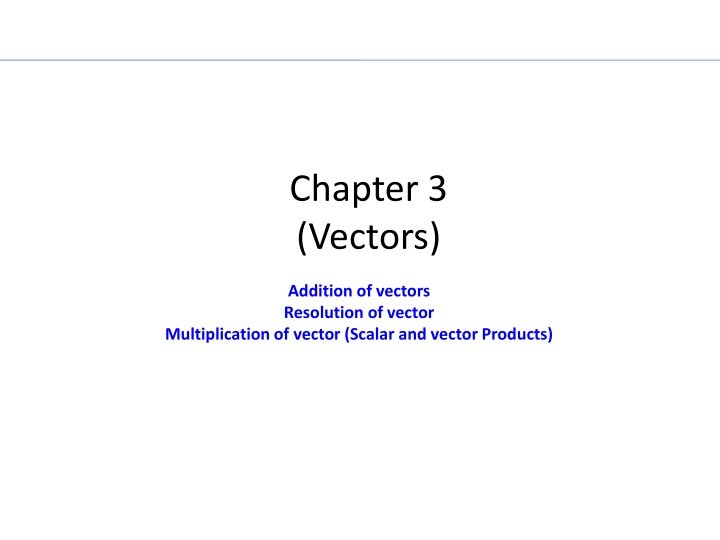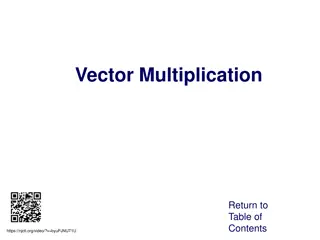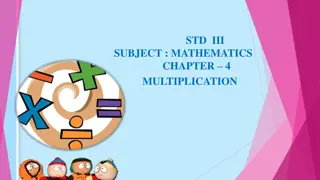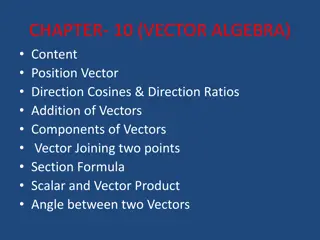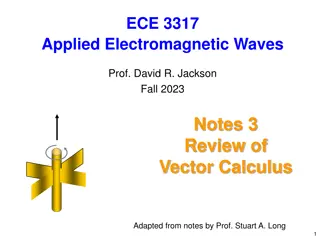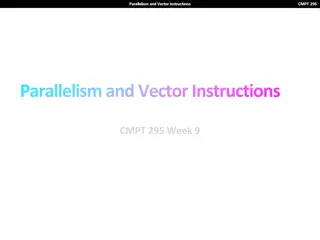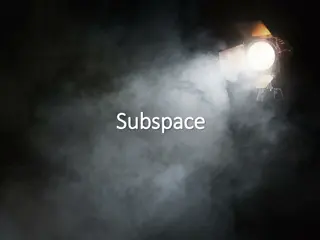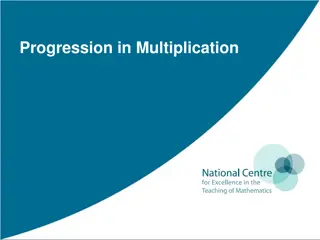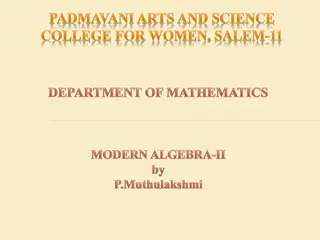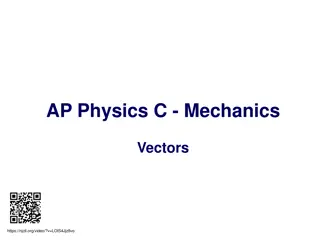Vector Operations: Addition, Resolution, and Multiplication
Fundamentals of vectors in Chapter 3, covering addition of vectors, resolution of vectors, and multiplication through scalar and vector products. Dive into concepts like negative and positive directions, unit vectors, vector notation, and examples illustrating vector operations in one dimension along the x and y axes. Understand how to calculate magnitudes, resultant vectors, and displacement using vector rules.
Download Presentation

Please find below an Image/Link to download the presentation.
The content on the website is provided AS IS for your information and personal use only. It may not be sold, licensed, or shared on other websites without obtaining consent from the author.If you encounter any issues during the download, it is possible that the publisher has removed the file from their server.
You are allowed to download the files provided on this website for personal or commercial use, subject to the condition that they are used lawfully. All files are the property of their respective owners.
The content on the website is provided AS IS for your information and personal use only. It may not be sold, licensed, or shared on other websites without obtaining consent from the author.
E N D
Presentation Transcript
Chapter 3 (Vectors) Addition of vectors Resolution of vector Multiplication of vector (Scalar and vector Products)
Lecture 1 Addition of vectors Resolution of vector
Right Angle Triangle Property Do you remember? Out of 4 (a, x, y, ) if you know 2 you can get other two = + 2 2 ( ) ( ) a x y y = a sin( ) y =? y x = a cos( ) x =? x If you know x and y, you can get a and If you know a and , you can get a y = tan x
Vector: One Dimension (x) Negative Direction (left) Positive Direction (Right) -3 -2 -5 -1 -4 3 0 4 1 5 2 start X-direction is represented by unit vector i or i X X X i ) X ( i Direction Magnitude ) = i ( i X X = X X Vector notation: Vector notation: = = 2) . ( X X X X Magnitude: X = 2) (X Magnitude: i = X Unit vector: X
Add or Subtract: One Dimension A B i Resultant vector: i i ) i = + = + ( R A B A B i Rule 1: Put the head of vector A to the tail of vector B = + 2) ( R A B Magnitude: ( + ) A B i Rule 2: The resultant vector will be the line joining the tail of A to the head of B A i Resultant vector: i i ) = = ( R A B A B i ( i ) B = 2) ( R A B Magnitude: ( ) A B i
Example: Position is measured from a starting point called origin (start). i i -3 -2 -5 -1 -4 3 0 4 1 5 2 start 0 Rule 1: Put the head of vector 1 to the tail of vector 2 3 cm 2cm 5 cm 5 cm i 3 cm i Rule 2: The resultant vector will be the line joining the tail of 1 to the head of 2 Resultant displacement = 5cm i + 3 cm i = 8 cm i = = 2= i 8 . 8 8 ( ) cm 8 x i Magnitude:
Vector: One Dimension (y) y-direction is represented by unit vector j or j Positive y-direction (j) 5 4 Magnitude 3 Magnitude Y 2 j ( j ) Y Y 1 Y Direction 0 Direction negative y-direction (-j) -1 -2 = Y j Y Vector notation: -3 = ( j ) Y Y Vector notation: -4 Y = = 2) (Y Magnitude: -5 Y = 2) (Y Magnitude: j Y Unit vector: Y Rule of addition and subtraction are same as x-direction.
Example: Rule 1: Put the head of vector 1 to the tail of vector 2 4 cm (-j) Rule 2: The resultant vector will be the line joining the tail of 1 to the head of 2 8 cm j 4 cm j Resultant displacement = 8 cm j - 4 cm j = 4 cm j = = 2= i 4 . 4 ( 4 ) cm 4 y i Magnitude: 0
3D: Unit Vectors i , j, k or are unit vectors representing x- y and z-directions respectively k j i , , 5 4 j k 3 2 i i i 1 j 0 -2 -5 -1 3 4 1 -4 -3 2 5 -1 -2 j -3 -4 -5
Triangle Law of Vector: Vector addition Rule 1: Put the head of vector 1 to the tail of vector 2 Rule 2: The resultant vector will be the line joining the tail of 1 to the head of 2 Note: You are free to move vector without changing its direction (angle) ay j B i + j = a a a x y ay a j i ) j = + ( a a x y ax i ) ax ( i C A Resultant vector: i + j = a a a x y 2 a = a Magnitude(Length) of AC: x x 2 a = a Magnitude(Length) of BC: = + 2 2 ( ) ( ) a a a Magnitude: y y x y = + 2 2 ( ) ( ) a a a Magnitude(Length) of AB: x y a y = tan a y = tan a a x x
Example: j This means the ant moved 5-steps along x-direction and 4-steps along y-direction B 4j i 0 A AB=5i+ 4j 5i There are two ways for the ant to reach from point A to B Magnitude of x component Magnitude of y component + 2 2 ( 5 ) ( 4 ) Magnitude (length) of AB =
Example 2: j B 5i i 0 A C
Checkpoint: j B ? i 0 A C 1. In the vector diagram which one is resultant? Answers: 1. AB 2. -3i+7j 3. AC 4. 3i-7j 2. Find the vector vector CB ! 3. In the vector diagram which one is resultant ? 4. Find the vector BC !
Is it True? j CB =-3i+7j AB is Resultant B i 0 A You can move any vector without changing its direction and magnitude. C You can put all the vectors with their tail at origin. The resultant vector is always in between the two vectors which make it.
Is it True? j AC is Resultant B i 0 A You can move any vector without changing its direction and magnitude. C You can put any vector with its tail at origin. BC =3i-7j The resultant vector is always in between the two vectors which make it.
Checkpoints Answers: c, d, f
Vector Resolution: Breaking one vector into two j What is x component? What is y-component? What is angle with x-axis? 4j 8 (-i) i 0 5i 9 (-j)
Vector Resolution: Breaking one vector into two Resolution is just opposite of vector addition i + j = a a a x y ay j i ) j = + ( a a a x y ay j ax i ) ax ( i Resultant vector: i + j = a a a 2 a = a Magnitude of x -component: x y x x 2 a = a Magnitude of x -component: y y = + 2 2 ( ) ( ) a a a Magnitude: x y = + 2 2 ( ) ( ) a a a Magnitude of a: x y
Vector Resolution: Angular components We can break one vector into two or more perpendicular vector components a ) sin( a j a ) cos( a j ) cos( a i ) i sin( )( a Resultant vector: ) ) = + cos( sin( a a i a j Cos: goes with the side where angle is formed Sin: goes to the opposite side of the angle Prove that: a = a Magnitude:
Resolution of vector dy j dy j -dxi -dxi dxi dxi -dy j -dy j
Vector Properties 1. You can extend the vector along its direction. 2. The angle has to be measured from arrow to arrow. 3. You can rotate all vectors together to align one vector in the horizontal direction if horizontal direction is not defined. y 4. Resolve other vectors into x and y directions. B sin( ) y x x B cos( )
Checkpoints a) i and j b) i and j c) i and j d1 d1x j (d1x +d2x )j d2xi (d1x +d2x)i d1xi d1 d2x (-j)
Sample Problmem: Page 45 a) What is the magnitude of r? b) What is the direction of r? Answers: a) 3.5 m b) -41o
Lecture 2 Multiplication of vector (Scalar and vector Products)
Multiplication of vectors There are two types of vector Multiplication: 1. Scalar Product (Multiplication) 2. Vector Product (Multiplication) a a Sin b a Cos Scalar Product: Dot Product . b a S = = Vector Product: Cross Product ( ) a b Cos = = ( ) V a b a b Sin n Result is always a scalar Result is vector and its direction is perpendicular (normal) to the both original vectors
Multiplication of vectors a b by ay bx ax Vector Product: Cross Product Scalar Product: Dot Product . ) k = = + ( V a b a b k a b x y y x = = + S a b a b a b x x y y k k ay by bx x ay by ax ax bx
Multiplication of vectors a b by ay bx ax Vector Product: Cross Product Scalar Product: Dot Product . k ) k = = + ( V b a b a b a y x x y = = + S b a b a b a x x y y k k ay by bx x ay by ax ax bx
3 Dimensional vector direction j X . Out of the page (k) Into the page (-k) i
Scalar Product Scalar products of unit vectors a i i i . k i b = = . 0 i j j = . 1 i j j = = . . 0 k = . 1 j k k = = . . 0 j k k = . 1 The result of scalar multiplication between vectors a and b is: = . ( ) a b a b Cos Prove this! i i = i = ij = ) 2 . . cos( cos( ) 0 90 1 i j Final result is scalar = 0 This is also called dot product
Scalar Multiplication: Dot product i i = . 1 j j = . 1 b a k k = . 1 i . k i = = . 0 i j j Any vector can be written in its components + = i = = . . 0 k j j + a a i a a k = = . . 0 j k k x y z i + j = + + b + b b b k + x y z i j a = + . ( ).( ) b a a j a k b i b b k x y z x y z 0 0 i i + 0 i j i a = + + . + ( i . ) ( . ) ( j . ) b a b a b a b k 0 x x x y x z j 0 0 + ( . ) ( . ) ( . ) a b j a b j a b k y x y y y z j + + + ( . ) ( . ) ( . ) a b k i a b k a b k k z x z y z z a . = + + b a b a b a b x x y y z z Final result is scalar
Vector Product vector products of unit vectors = j i i 0 = = i j j i k a j = 0 = = k i i k j b k = 0 k = = j k k j i Proof The result of vector multiplication between vectors a and b is: = = 2 sin( ) 0 0 i i i n = sin( ) a b a b i j This is also called cross product n cap represents the direction of a x b which is normal to a as well as b Learn this rule! k Clockwise + ve Anticlockwise - ve
Vector Multiplication: Cross product b i a j k Any vector can be written in its components = j + a a i a x y Clockwise + ve Anticlockwise - ve i j = + b b b x y i j i j a = + + ( ) ( ) b a a b b x y x y 0 i i i 0 j a = + ( i ) ( ) b a b a b x x x y j j j + ( ) ( ) a b a b y x y y a = + ( k ) b a b k a b x y y x Final result is vector
Checkpoints Answers: a) 90o b) 0o c) 180o
3- ideas in this chapter 1. Vector addition ( getting resulting vector) b a 2. Resolution of vector (Breaking vector into its components) a a asin( )j ayj acos( )i axi 3. Multiplication of vectors n = sin( = ) a b a b . ( ) a b a b Cos You can get mixed concepts as well
Problem Solving strategy 1. Read the questions carefully and underline the given quantities and clue points. 2. Figure out what you need to find. 3. Draw a diagram and write down the given quantities. 4. Solve for the unknown. Q8. Consider two vectors A = (3 i + 4 j) cm and B = (- 4 i + 3 j) cm. Find the angle between these two vectors. (Ans: 90 degrees) Alternative method . ? = cos( ) A B A B 4j 3j . A B = 1 cos 3i -4i A B Find these angles
Sample Question Q8. Two vectors are given as: angle between the vectors A A)23 k k i . j i j = + 0 . 5 + = + 0 . 3 + and . Find the 0 . 3 0 . 4 0 . 5 0 . 4 A and B B Exmaple 2: A vector A is defined as A = 1.5i +1.5j. Find a vector B that makes an angle of 600 with A in the counterclockwise direction and has magnitude of 4 units. Ans: -1.04 i +3.86 j
Sample Problem (Page 42) N East of North West of North Answers: dx =81 Km dy = 199 Km W E West of South East of South Always make angle with last direction. Example: 22o East of North, make angle with North 22o North of East, make angle with East S
Sample Question: Page 46 An ants make 5 moves as shown in figure, a. Draw the diagram of resultant vector b. If each move is 6.0 cm what is the net displacement vector c. What is the magnitude of net displacement? d. What is the angle of the net displacement? Answers: b) - 8.2 cm i + 3.8 cm j c) 9.0 cm d) -24.8o
T102-Ch3 Q7. A man leaves his house and makes three successive displacements. The first displacement is D1 (10.0 km, 60.0 ), the second displacement D2 is unknown, and the third displacement D3 is (10.0 km, 240 ). Find the second displacement D2 if his resultant displacement is (20.0 km, 90.0 ). All angles are measured counter clockwise with respect to the positive x-axis. 1 and 2 (20.0 km, 90.0 ) Q8. Two vectors are given as: angle between the vectors A A)23 k k i . j i j = + 0 . 5 + = + 0 . 3 + and . Find the 0 . 3 0 . 4 0 . 5 0 . 4 A and B B 1 Q9. Three vectors are given by Find ( C B A A)0 j i j i j = 0 . 3 + = = 0 . 2 + , and . 0 . 3 1.0 4.0 0 . 2 A B i C . ) 3
T101-Ch3 1 and 2 1 3
T92-Ch3 1 and 2 3 1 and 2
T91-Ch3 Q7. A car travels 30 km due south and then D km in an unknown direction. The magnitude of the resultant displacement is 50 km and its direction is 53o west of south. Find the magnitude and direction of the unknown displacement D. A) 40 km due west 1 and 2 1 and 2 Q9. Which one of the following statements concerning vectors and scalars is FALSE? A) A vector that has zero magnitude may have components other that zero. B) A vector that has a negative component, has a positive magnitude. C) A scalar component may be either positive or negative. D) Two vectors are equal only if they have the same magnitude and same direction. E) In calculations, the vector components of a vector may be used in place of the vector itself. 1 and 2
Examples: T82-Ch3 Q7. Vector A has a magnitude of 40.0 cm and is directed 60.0 degrees above the negative x-axis. Vector B has magnitude of 20.0 cm and is directed along the positive x-axis. Find the resultant vector (i and j are unit vectors along positive x and y axes, respectively). (Ans: 34.6 j cm) 1 and 2 Q8. Consider two vectors A = (3 i + 4 j) cm and B = (- 4 i + 3 j) cm. Find the angle between these two vectors. (Ans: 90 degrees) 1 and 3 Q9. If vector A is added to vector B, the result is (6 i + 1j) m. If A is subtracted from B, the result is (- 4 i + 7 j) m. Find the magnitude of B. (Ans. 4 m.) 1 and 2
T81-Ch3 Q7. A boat travels a distance of 27.0 km 20.0o North of East. It then travels 53.0 km in a direction 30.0o East of North. What is the total distance traveled by the boat in the East direction? ( Ans: 51.9 km) 1 and 2 Q8. Consider two vectors A and B with magnitudes 5 cm and 8 cm, respectively. Vector A is along the positive x-axis and vector B is along the positive y-axis. Find A. (B+A): (Ans: 25 cm2) 1 ,2 and 3 i j i j k k = + = + + i j A B k 5 2 5 2 4 3 = C Q9. Consider the following three vectors , , and Find the magnitude of the vector D = A B + 2C. (Ans: 17.7) 2 3 1
T-72-Ch3 Q5.Vectors , a , b and c are related through equations a + b = c and a b = 5.0 c . If c = 3 i + 4 j , what is the magnitude of vector a ? (Ans: 15) 1 3
